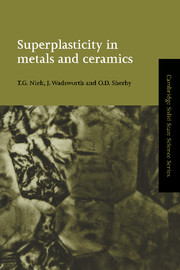Book contents
- Frontmatter
- Contents
- Preface
- Chapter 1 Introduction
- Chapter 2 Key historical contributions
- Chapter 3 Types of superplasticity
- Chapter 4 Mechanisms of high-temperature deformation and phenomenological relations for fine-structure superplasticity
- Chapter 5 Fine-structure superplastic metals
- Chapter 6 Fine-structure superplastic ceramics
- Chapter 7 Fine-structure superplastic intermetallics
- Chapter 8 Fine-structure superplastic composites and laminates
- Chapter 9 High-strain-rate superplasticity
- Chapter 10 Ductility and fracture in superplastic materials
- Chapter 11 Internal-stress superplasticity (ISS)
- Chapter 12 Other possible superplasticity mechanisms
- Chapter 13 Enhanced powder consolidation through superplastic flow
- Chapter 14 Superplastic forming and diffusion bonding
- Chapter 15 Commercial examples of superplastic products
- Index
Chapter 7 - Fine-structure superplastic intermetallics
Published online by Cambridge University Press: 15 October 2009
- Frontmatter
- Contents
- Preface
- Chapter 1 Introduction
- Chapter 2 Key historical contributions
- Chapter 3 Types of superplasticity
- Chapter 4 Mechanisms of high-temperature deformation and phenomenological relations for fine-structure superplasticity
- Chapter 5 Fine-structure superplastic metals
- Chapter 6 Fine-structure superplastic ceramics
- Chapter 7 Fine-structure superplastic intermetallics
- Chapter 8 Fine-structure superplastic composites and laminates
- Chapter 9 High-strain-rate superplasticity
- Chapter 10 Ductility and fracture in superplastic materials
- Chapter 11 Internal-stress superplasticity (ISS)
- Chapter 12 Other possible superplasticity mechanisms
- Chapter 13 Enhanced powder consolidation through superplastic flow
- Chapter 14 Superplastic forming and diffusion bonding
- Chapter 15 Commercial examples of superplastic products
- Index
Summary
Ordered intermetallic alloys and their composites generally have good high-temperature strength, low density, and environmental resistance and are, therefore, potential materials for high-temperature structures. However, ordered intermetallic alloys are also known to be brittle, have low toughness because of their ordered structure, and show a propensity for grain-boundary embrittlement. As a result, intermetallic alloys often either have poor fabricability and machinability or require a fabrication process that is complicated and tedious. The generic brittleness problem in intermetallics, particularly aluminides, has been studied extensively in recent years and some breakthroughs have been made. For example, polycrystalline Ni3Al that has an Ll2 structure exhibits almost no ductility, but Ni3Al containing a small amount (0.2 wt%) of boron exhibits room-temperature tensile ductility of up to 40%. Because of these technological breakthroughs, there is great interest in using these materials for engineering structures.
Superplasticity in intermetallics has only been recently demonstrated. Although large tensile elongations (∼100%) for an intermetallic (also known as Sendust, Fe–9.6 wt% Si–5.4 wt% Al) were indicated as early as 1981, true superplastic intermetallics were not observed until 1987. At present, several intermetallics of the Ll2 structure (e.g., Ni3Al and Ni3Si), iron aluminide, titanium aluminide (TiAl), and trititanium aluminides (Ti3Al) have demonstrated superplasticity. These intermetallics are being investigated for their structural applications.
- Type
- Chapter
- Information
- Superplasticity in Metals and Ceramics , pp. 125 - 144Publisher: Cambridge University PressPrint publication year: 1997
- 5
- Cited by



